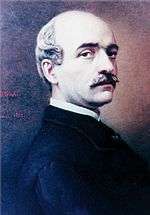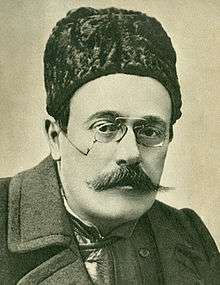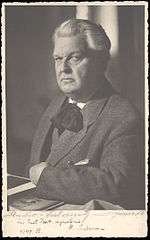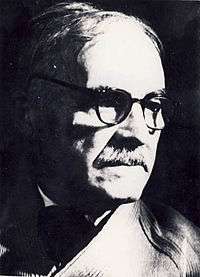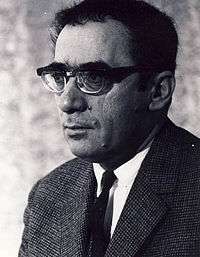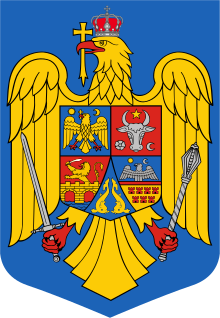Romanian literature
Romanian literature is literature written by Romanian authors, although the term may also be used to refer to all literature written in the Romanian language.
| Part of a series on the |
| Culture of Romania |
|---|
 |
| History |
| People |
| Languages |
|
Mythology and folklore
|
|
Festivals |
|
|
|
Music and performing arts
|
|
Media |
| Sport |
|
Organisations |
|
History
Beginnings
| Reformation era literature |
|---|
The earliest surviving document in Romanian is Neacșu's Letter written in 1521, to the jude ("judge and mayor") of Brașov, Hans Benkner.
Romanian culture was heavily influenced by the Eastern Orthodox Church, the official stance of the Romanian Church being that Orthodoxy was brought to the Romanian land by the Apostle Andrew. According to some modern Romanian scholars, the idea of early Christianisation is unsustainable, being used for propaganda purposes in the totalitarian era as part of the ideology of protochronism, which purports that the Orthodox Church has been a companion and defender of the Romanian people for its entire history. The earliest translated books into Romanian were Slavonic religious texts from the 15th century. The Psalter of Șchei (Psaltirea Șcheiană) of 1482 and the Voroneț Codex (Codicele Voronețean) are religious texts that were written in Maramureș.
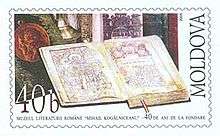
The first book printed in Romania was a Slavonic religious book in 1508. The first book printed in the Romanian language was a Protestant catechism of Deacon Coresi in 1559, printed by Filip Moldoveanul. Other translations from Greek and Slavonic books were printed later in the 16th century. Dosoftei, a Moldavian published in Poland in 1673, was the first Romanian metrical psalter, producing the earliest known poetry written in Romanian.
Early efforts to publish the Bible in Romanian started with the 1582 printing in the small town of Orăștie of the so-called Palia de la Orăștie – a translation of the first books of the Old Testament - by Deacon Şerban (a son of the above-mentioned Deacon Coresi) and Marien Diacul (Marien the Scribe). Palia was translated from Latin by Bishop Mihail Tordaș et al., the translation being checked for accuracy using Hungarian translations of the Bible.
The entire Bible was not published in Romanian until the end of the 17th century, when monks at the monastery of Snagov, near Bucharest, translated and printed "Biblia de la București - "The Bucharest Bible" in 1688.
European humanism came to Moldavia in the 17th century via Poland with its representative, Miron Costin, writing a chronicle on the history of Moldavia. Another humanist was Dimitrie Cantemir, who wrote histories of Romania and Moldavia.
Ottoman Decadence and Phanariotes
The 18th century in the Romanian lands was dominated by the Ottoman Empire, which decided not to allow Romanian rulers in Wallachia and Moldavia and ruled, instead, through Greek merchants of Istanbul, called phanariotes.
Thus, Greek culture influenced the developments of Romanian literature. For example, one of the greatest poets of this century was Alecu Văcărescu, who wrote love songs in the tradition of ancient Greek poet Anacreon. His father, Ienăchiţă, was a poet as well, but he also wrote the first Romanian grammar and his son, Iancu, was probably one of the greatest poets of his generation. A human comedy was developed in the anecdotes of Anton Pann, who tried to illustrate a bit of the Balkanic spirit and folklore which was brought by the Ottomans in the Romanian lands.
However, the next generation of Romanian writers headed toward European Illuminism for inspiration, among them Gheorghe Asachi, Ion Budai-Deleanu and Dinicu Golescu.
National awakening
As the revolutionary ideas of nationalism spread in Europe, they were also used by the Romanians, who desired their own national state, but were living under foreign rule. Many Romanian writers of the time were also part of the national movement and participated in the revolutions of 1821 and 1848. The Origin of the Romanians began to be discussed and in Transylvania, a Latinist movement Şcoala Ardeleană emerged, producing philological studies about the Romanic origin of Romanian and opening Romanian language schools.
Romanians studied in France, Italy and Germany, and German philosophy and French culture were integrated into modern Romanian literature, lessening the influence of Ancient Greece and the Orient over time. In Wallachia an important figure of the time was Ion Heliade Rădulescu, who founded the first Romanian-language journal and the Philharmonic Society, which later created the National Theatre of Bucharest.
The most important writers of the second half of the century were Vasile Alecsandri and later Mihai Eminescu. Alecsandri was a prolific writer, contributing to Romanian literature with poetry, prose, several plays, and collections of Romanian folklore. Eminescu is considered by most critics to be the most important and influential Romanian poet. His lyric poetry had many of its roots in Romanian traditions, but was also influenced by German philosophy and Hindu traditions.
Titu Maiorescu's Junimea literary circle, founded in 1863 and frequented by many Romanian writers, played an important role in Romanian literature. Many outstanding Romanian writers, including Ion Luca Caragiale, who wrote some of the best Romanian comedies, Ion Creangă, who wrote traditional Romanian stories and Barbu Ştefănescu Delavrancea, published their works during this time. George Coșbuc was a poet, translator, teacher, and journalist, best known for his verses describing, praising and eulogizing rural life. Nicolae Bălcescu, Dimitrie Bolintineanu, Alecu Russo, Nicolae Filimon, Bogdan Petriceicu Hasdeu, Alexandru Odobescu, Grigore Alexandrescu, Constantin Negruzzi, Alexandru Vlahuță, Alexandru Macedonski, Petre Ispirescu, Duiliu Zamfirescu and Ioan Slavici are also important literary personalities of the era.
Interbellum literature
After achieving national unity in 1918, Romanian literature entered what can be called a golden age, characterized by the development of the Romanian novel. Traditional society and recent political events influenced works such as Liviu Rebreanu's Răscoala ("The Uprising"), which, published in 1932, was inspired by the 1907 Romanian Peasants' Revolt, and Pădurea Spânzuraţilor ("Forest of the Hanged"), published in 1922 and inspired by Romanian participation in World War I. The dawn of the modern novel can be seen in Hortensia Papadat-Bengescu (Concert din muzică de Bach—"Bach Concert"), Camil Petrescu (Ultima noapte de dragoste, întâia noapte de război—"The Last Night of Love, the First Night of War"). George Călinescu is another complex personality of the Romanian literature: novelist, playwright, poet, literary critic and historian, essayist, journalist. He published authoritative monographs about Eminescu and Creangă, and a monumental (almost 1,000 pages in quarto) history of Romanian literature from its origin to the time of his writing (1941).
An important realist writer was Mihail Sadoveanu, who wrote mainly novels which took place at various times in the history of Moldova. But probably the most important writers were Tudor Arghezi, Lucian Blaga and Mircea Eliade. Tudor Arghezi revolutionized Romanian poetry 50 years after Eminescu, creating new pillars for the modern Romanian poem. Lucian Blaga, one of the country's most important artistic personalities, developed through his writings a complex philosophic system, still not perfectly understood even today. Mircea Eliade is today considered the greatest historian in the field of religions. His novels reveal a mystical, pre-Christian symbolism paving the way for contemporary Romanian art.
Born in Romania, Tristan Tzara, a poet and essayist, is the main founder of Dada, a nihilistic revolutionary movement in the arts, and may have been responsible for its name (Romanian for "Yes yes"). Later he abandoned nihilism for Surrealism and Marxism. For the first time in its history, Romanian culture was fully connected to Western culture, while Dadaism is the first Romanian artistic and literary movement to become international. Dadaism and Surrealism are fundamental parts of the avant-garde, the most revolutionary form of modernism. The Romanian avant garde is very well represented by Ion Minulescu, Gherasim Luca, Urmuz, Perpessicius, Tristan Tzara, Grigore Cugler, Geo Bogza, Barbu Fundoianu, Gellu Naum, Ilarie Voronca, and Ion Vinea. Max Blecher was a poet whose life was cut short by health problems.
George Bacovia was a symbolist poet. While he initially belonged to the local Symbolist movement, his poetry came to be seen as a precursor of Romanian Modernism. Some important literary figures of this period were also active in other domains. Vasile Voiculescu was a Romanian poet, short-story writer, playwright, and physician. Ion Barbu was a poet, as well as an important mathematician.
Cezar Petrescu was a journalist, novelist and children's writer. He is especially remembered for his children's book Fram, ursul polar ("Fram, the polar bear"—the circus animal character was named after Fram, the ship used by Fridtjof Nansen on his expeditions). Elena Farago was also a children's writer and poet.
Ion Agârbiceanu was a writer, as well as a politician, theologian and Greek-Catholic priest. Gala Galaction was another writer, who was also an Orthodox clergyman and theologian.
Other literary figures of this era include Ionel Teodoreanu, Panait Istrati, Gib Mihăescu, Otilia Cazimir, and George Topîrceanu.
Communist Era
Marin Preda is often considered the most important post-WWII Romanian novelist. His novel Moromeţii ("The Moromete Family") describes the life and difficulties of an ordinary peasant family in pre-war Romania and later during the advent of Communism in Romania. His most important book remains Cel mai iubit dintre pământeni ("The Most Beloved of Earthlings"), a cruel description of communist society. Zaharia Stancu published his first important novel, Desculț (Barefoot), in 1948.
Some of the most important poets are Nichita Stănescu, Marin Sorescu, Ana Blandiana, Leonid Dimov and Ștefan Augustin Doinaș. An important novelist of this era was Radu Tudoran.
Outside Romania, Eugène Ionesco and Emil Cioran represented the national spirit at the highest level. Eugène Ionesco is one of the foremost playwrights of the Theatre of the Absurd. Beyond ridiculing the most banal situations, Ionesco's plays depict in a tangible way the solitude of humans and the insignificance of one's existence, while Cioran was a brilliant writer and philosopher.
Contemporary literature
Some Romanian contemporary writers:
- Gabriela Adameșteanu
- Ștefan Agopian
- Nicolae Breban
- Grid Modorcea
- Svetlana Carstean
- Mircea Cărtărescu
- Traian T. Coșovei
- Gheorghe Crăciun
- Alexandru Ecovoiu
- Radu Pavel Gheo
- Florin Iaru
- Ion Bogdan Lefter
- Norman Manea
- Dan C. Mihǎilescu
- Herta Müller (2009 Nobel Laureate)
- Ion Mureșan
- Mircea Nedelciu
- Dora Pavel
- Simona Popescu
- Sorin Preda
- Doina Ruşti
- Cecilia Ștefănescu
- Dan Sociu
- Ion Stratan
- Bogdan Suceavă
- Cristian Teodorescu
- Răzvan Ţupa
- Dumitru Ţepeneag
- George Cornilă
- Radu Aldulescu
- Ioana Pârvulescu
- Tudor Dumitru Savu
- Ioan Groșan
- DR Popescu
- Nikita Stănescu
- Claudiu Komartin
Chronology: 19th century-present day
|
|
Translations of Romanian literature
- "Testament - Anthology of Modern Romanian Verse - Bilingual Edition - English/Romanian" (Daniel Ioniță, with Eva Foster and Daniel Reynaud; Editura Minerva 2012 - ISBN 978-973-21-0847-5). This presents a comprehensive selection of Romanian poetry from 1850 to the present (post 2010) covering 56 poets and over 75 poems. It includes classics such as Vasile Alecsandri, Mihai Eminescu, Ion Minulescu, George Cosbuc, Tudor Arghezi, Vasile Voicluescu, Nicolae Labis, as well as contemporaries such as Nichita Stanescu, Ana Blandiana, Marin Sorescu, Nora Iuga, Cezar Ivanescu, Ileana Malancioiu, Adrian Paunescu, George Tarnea, Mircea Cartarescu, Daniel Banulescu, Lucian Vasilescu, Adrian Munteanu, Ioan Es.Pop, Liliana Ursu, Doina Uricariu, Liliana Ursu, and others. The volume is prefaced by literary critic and historian Alex Stefanescu.
- " The Disheveled Maidens" (Hortensia Papadat-Bengescu, Romanian Cultural Institute Publishing House 2004)
- "Something is still present and isn't, of what's gone. - A Bilingual Anthology of Avant-Garde and Avant-Garde Inspired Rumanian poetry - English/Rumanian" (Victor Pambuccian; Aracne editrice, Rome 2018 - ISBN 978-88-255-1473-5). It includes poems of Tristan Tzara, B. Fundoianu, Ilarie Voronca, Geo Bogza, Max Blecher, Gherasim Luca, Gellu Naum, Geo Dumitrescu, Paul Celan, Ion Caraion, Nora Iuga, Nichita Stănescu, George Almosnino, Constantin Abăluță, Vintilă Ivănceanu, Daniel Turcea, Mariana Marin. The volume is prefaced by literary critic and historian of the Romanian avant-garde Mădălina Lascu.
See also
- List of Romanian novelists
- List of Romanian writers
References
- George Călinescu, Istoria literaturii române de la origini până în prezent ("The History of Romanian Literature from its origins till present day"), 1941
- Nicolae Iorga, Istoria literaturii româneşti ("The History of Romanian Literature"), 1929
- Alex Ștefănescu, Istoria literaturii române contemporane, 1941-2000 ("The History of Contemporary Romanian Literature, 1941-2000"), 2005
- Dan C Mihăilescu, Literatura română în postceaușism, Vol II, Proza. Prezentul ca dezumanizare, Ed. Polirom, 2006 Vol II, Proza. Prezentul ca dezumanizare, Ed. Polirom, 2006
External links
| Romanian Wikisource has original text related to this article: |
